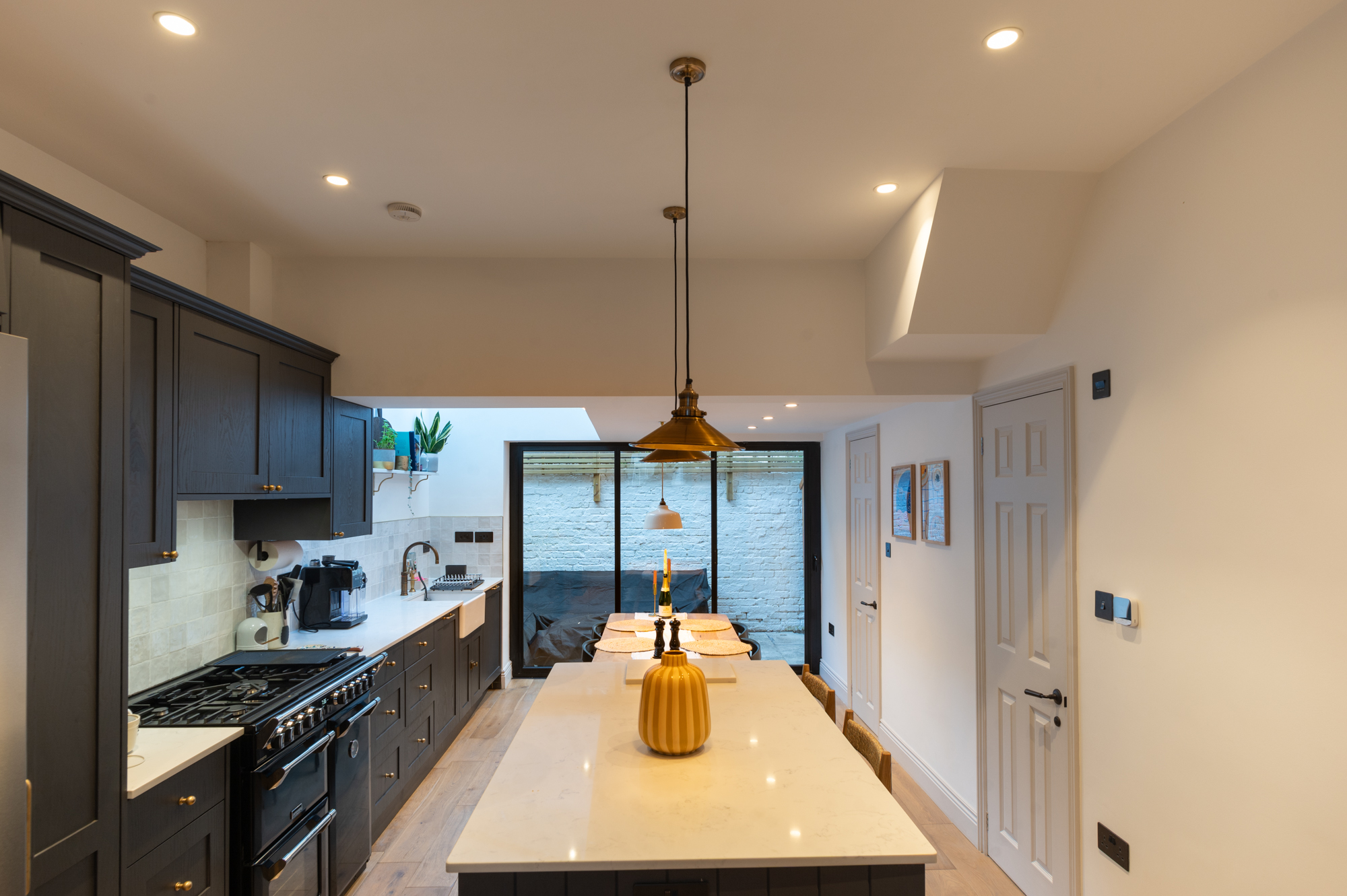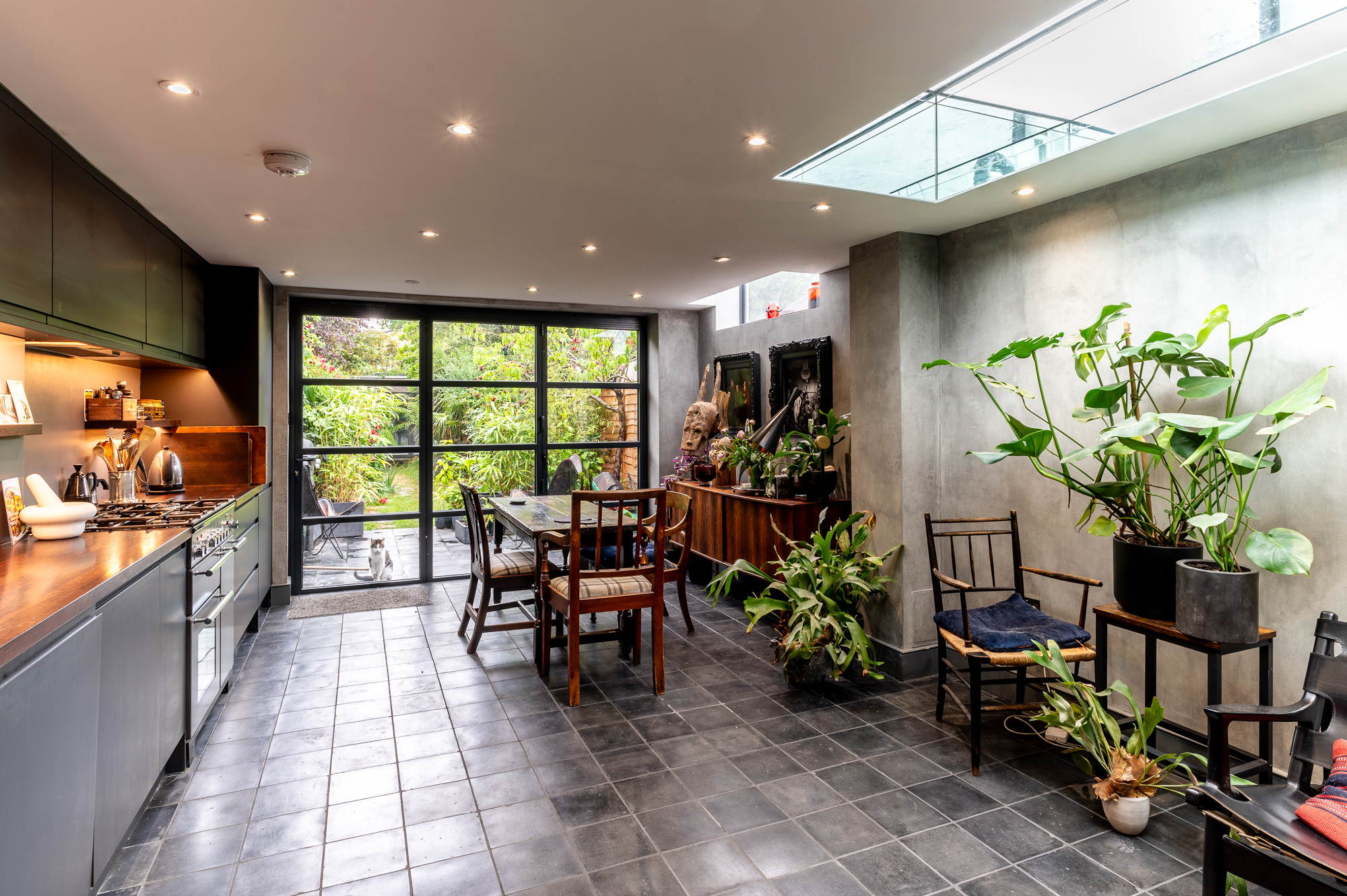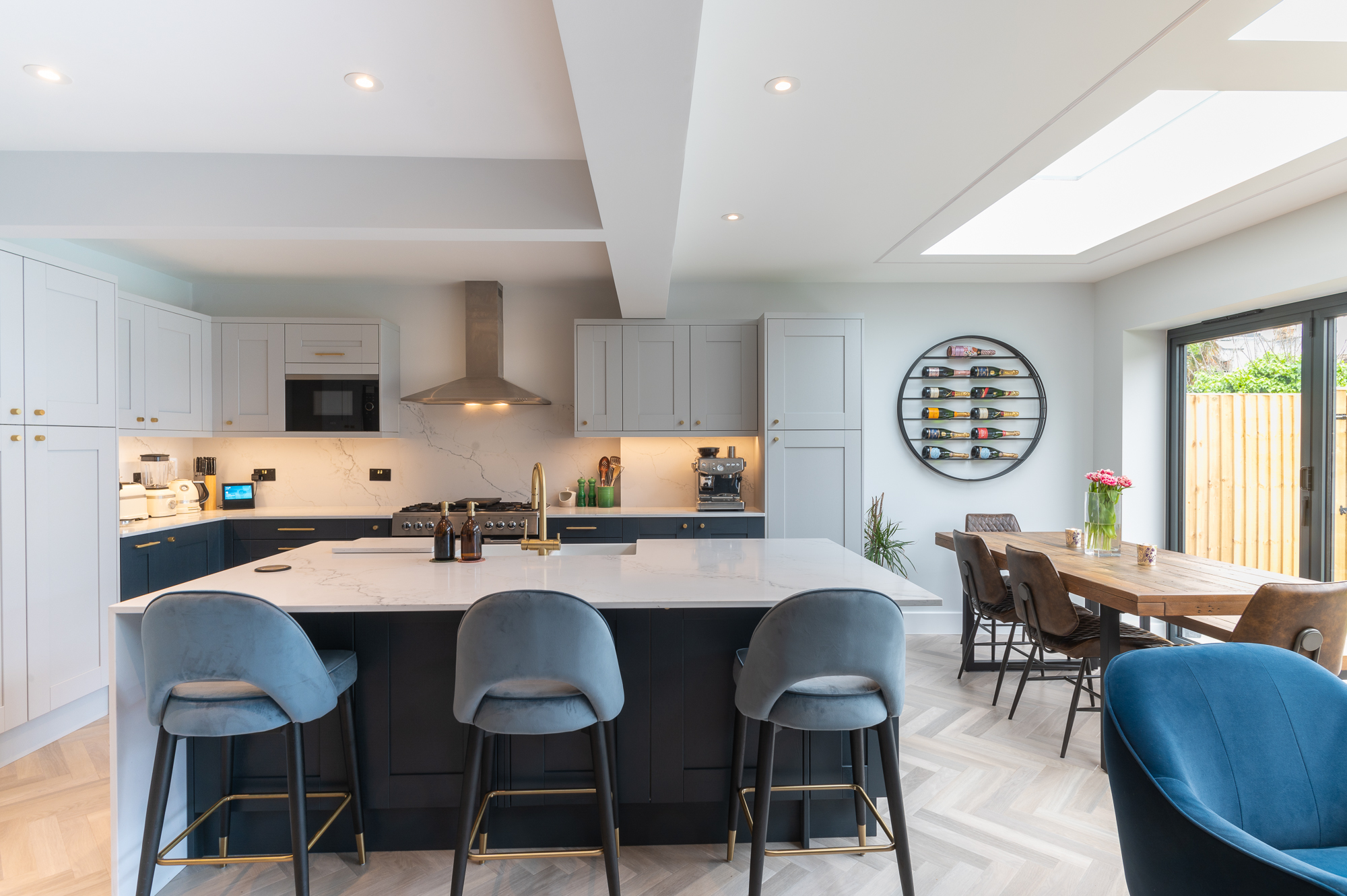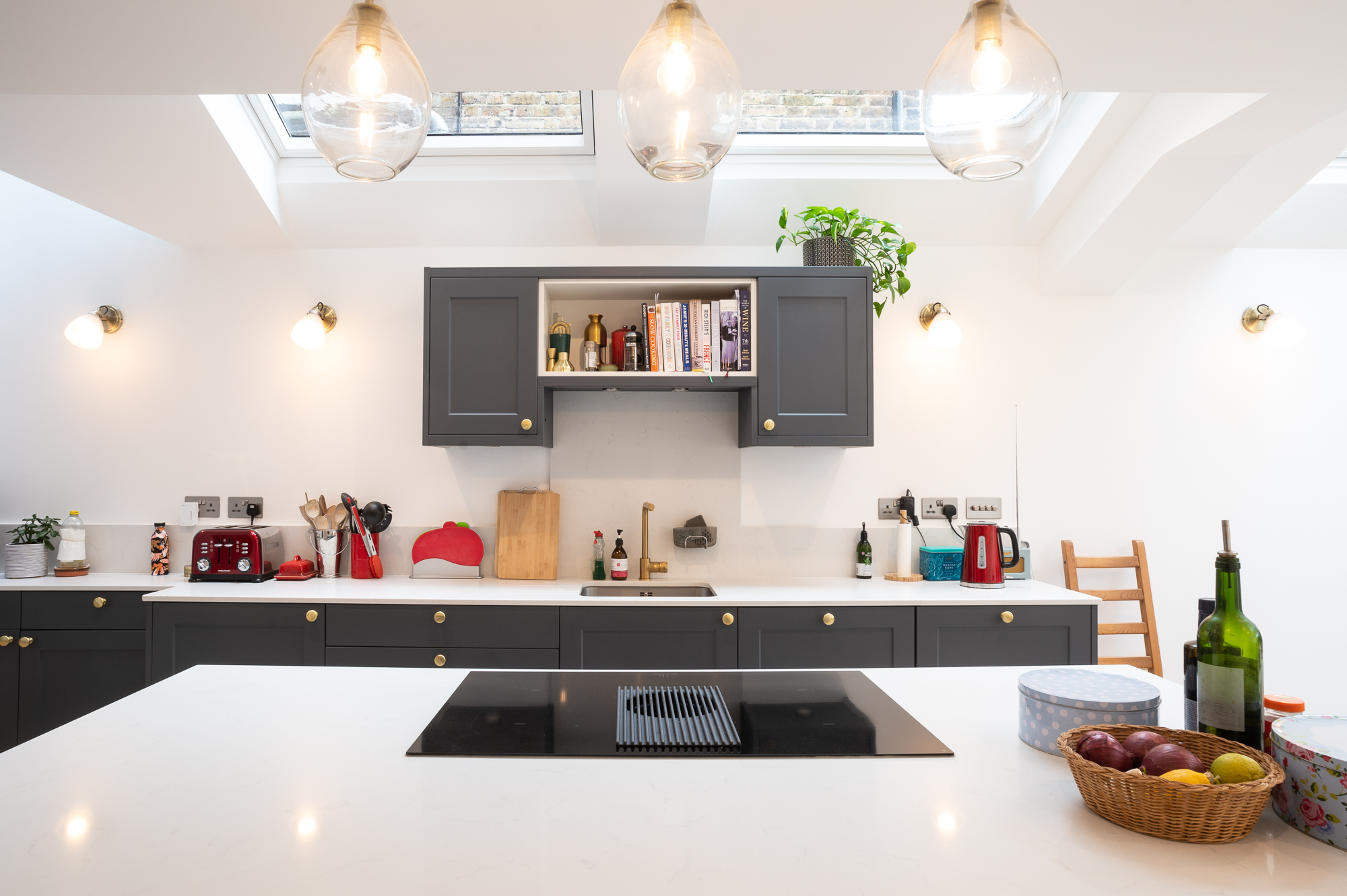Victorian Terrace House Design
Victorian era terrace homes are chock-full of charm and character; but they may not be entirely suited to modern living.
Fortunately, Victorian terrace home designs change all that by allowing you to restore, renovate, extend, and transform your property to create the ideal terrace home full of comfort, and style. All of this while adding space and value to your home.
But, for it to be a truly treasured investment, having the right expert help may just make all the difference.
Though a highlight of classical British architecture, Victorian homes have a lot of potential and flexibility in how they may be redesigned and adapted to suit growing families and modern lifestyles. Some of the most popular designs for Victorian terraced homes include:
Rear extensions
Built on the rear of a property, these extensions offer incredible versatility in their design and use. Rear extensions are generally utilised to create kitchen extensions, guest rooms, or even office pods and playrooms.
Side return extensions
Side return extensions utilise the area that runs along the side of a property as well as a portion of the rear. They are ideal for creating beautiful indoor-outdoor connections that bring in abundant light and ventilation to a home.
Wrap around extensions
Wrap around extensions are a combination of side and rear extensions that creates an L-shaped structure that ‘wraps’ around the property. These extensions add great width and depth, and therefore can be used to create multiple rooms, large kitchen-diners, or even open floor plans.
Multi-storey extensions
Two storey extensions, though more complex than single storey extensions, add incredible floor space to a property. They are also extremely cost-effective as they effectively double the square footage of the extension without doubling the roofing and excavation costs. Multi-storey extensions help create multiple rooms and bathrooms within the property.
Loft conversions
A popular option among homeowners, loft conversions offer incredible potential in their design and are perfect for adding that extra bedroom or office nook that adds so much value to a property. Loft conversions utilise the awkward loft corners and convert these spaces into valuable living space.
The need for planning permission for Victorian terrace homes is largely dependent on the designs and dimensions of the proposed renovations and/or extensions. This is because extensions and remodels that fall under permitted developments do not require planning permission.
Permitted developments, however, have specific criteria and size stipulations such as:
- Side extensions must be single-storied and must not exceed more than half the width of the original house.
- Extensions must not be higher than the highest part of the existing roof.
- The materials used on the exterior of the extension must be similar in appearance to the materials used on the exterior of the original house.
- Extensions must not take up more than half the land around the original house.
Moreover, home extensions that are built on properties listed in conservation areas invariably require planning permission.
For a comprehensive understanding of the requirements for planning permission and the specifications associated with permitted developments, property owners could also visit the planning portal.
Party wall agreements and building regulations approval must also be considered to ensure that the proposed terrace home design meets building guidelines and standards.
Designing period homes usually requires seamlessly integrating contemporary design within the original structure, to create the perfect blend of classical and modern. This may be achieved through:
Kitchen extensions
With notoriously small kitchen-diners, Victorian terrace homes are primed for kitchen extensions. Rear or side return extensions are ideal for helping transform these kitchens to create beautiful, warm, and inviting spaces that, with the installation of the latest fittings, become ideally suited for your modern lifestyle.
Glazed walls
Installing glazed walls and bi-folding doors allows you to design incredible spaces that are full of natural light. These are also ideal for bringing the outdoors in, a feature that adds incredible style, while creating the perfect space for dining or even entertaining.
Open plan spaces
Not all homes require extensive extensions. Sometimes an innovative approach to transforming the existing space involves taking down the walls between rooms, changing the layout, creating an open floor plan, and installing well-placed skylights or windows to create a brighter and larger room.
Restoration of period features
Often, the best way to revive a Victorian terrace home is by repairing and restoring the features that make it so uniquely beautiful. Be it the ornate ceiling roses, the beautiful sash windows, or the wonderful hardwood floors. Designing, replacing, or recreating the original pieces of history can have an incredible effect on the overall look and value of your home.
Designing, re-inventing, and building the ideal Victorian terrace home can cost anywhere between £35,000 to £150,000.
This is because the cost of designing a Victorian terrace home depends on a number of factors such as:
- The size of the extension/renovation
- The type/ complexity of the design
- Location
- Groundwork
- Restoration work involved
- Building materials
- Fittings and fixtures
- Specialists’ fees
It is therefore a good idea to plan a budget that takes these factors into consideration in order to create the best possible terrace home.
Transforming your historic home to create additional living space that is both beautifully designed and specific to your requirements is no longer an implausible dream. At least not with Good Design and Build.
Being the foremost experts in designing, renovating, and extending Victorian and Edwardian homes, we are the perfect fit to create the best Victorian terrace home for you.
Our incredibly talented team of architects, builders, technicians, and project managers oversee every aspect of the design and build process from start to finish. From choosing the right materials and securing the requisite approvals, to contractual work and on-site management; we do it all.
Good Design and Build create beautiful, bespoke home designs that add space and value to your property, while retaining the beauty and architectural integrity of your home.
How we deliver projects
Our process is simple and divided into two distinct phases with separate contracts: Design and Build. As a client you only commit to one phase at a time depending on what stage of the process you are in. Each phase consists of three stages as described below.
1. Design
This is the kick-off point for your project. We carry out a complete architectural measured survey of the property. This allows us to create accurate CAD design drawings. This is followed by a design meeting to start discussing your ideas in more detail.
2. Planning
At this stage we finalise the designs with you and start preparing planning applications as needed. We place a high priority on ensuring that plans, designs and schedules are all based on a thorough and detailed understanding of planning guidelines. We co-ordinate with local authorities until the decision is made, and the planning approval is secured.
3. Technical
Once the planning consent is secured, we translate the design drawings into more detailed technical drawings for the purposes of building control and construction. This also includes specifications and structural calculations. At this stage, we will also submit to you our ‘no obligation’ quote for the build phase.
4. Pre-build
90% of our clients decide to stick with us after the design phase is completed. Once the build contract is signed, we kick off the process by making sure all the pre-build processes are complete. These include assistance with party wall agreements, Thames Water build over agreement, submitting building control application, and preparing method statements etc as needed. This stage ends with a pre-start meeting with your foreman before the actual build begins.
5. Build
One of our foremen will be dedicated to your project and will be on-site to manage everyday works. Our project managers will be overseeing the works to make sure they are completed to high standards, within your budget and on time. Throughout the process we will keep you updated with the progress and coordinate the works with third parties such as kitchen or flooring suppliers. We will also advise and guide you to choose any suppliers if needed.
6. Handover
As the build draws to finish, we will help to iron out any ‘snags’ to make sure everything is completed to your satisfaction. We will put together all necessary certificates such as gas, electricity and building control completion along with warranties for glazing, boiler etc. At the final completion meeting, we will hand you these documents, together with the keys to your house. Needless to say, you can contact us any time after this, if you want us to look at something.
This is the kick-off point for your project. We carry out a complete architectural measured survey of the property. This allows us to create accurate CAD design drawings. This is followed by a design meeting to start discussing your ideas in more detail.
At this stage we finalise the designs with you and start preparing planning applications as needed. We place a high priority on ensuring that plans, designs and schedules are all based on a thorough and detailed understanding of planning guidelines. We co-ordinate with local authorities until the decision is made, and the planning approval is secured.
Once the planning consent is secured, we translate the design drawings into more detailed technical drawings for the purposes of building control and construction. This also includes specifications and structural calculations. At this stage, we will also submit to you our ‘no obligation’ quote for the build phase.
90% of our clients decide to stick with us after the design phase is completed. Once the build contract is signed, we kick off the process by making sure all the pre-build processes are complete. These include assistance with party wall agreements, Thames Water build over agreement, submitting building control application, and preparing method statements etc as needed. This stage ends with a pre-start meeting with your foreman before the actual build begins.
One of our foremen will be dedicated to your project and will be on-site to manage everyday works. Our project managers will be overseeing the works to make sure they are completed to high standards, within your budget and on time. Throughout the process we will keep you updated with the progress and coordinate the works with third parties such as kitchen or flooring suppliers. We will also advise and guide you to choose any suppliers if needed.
As the build draws to finish, we will help to iron out any ‘snags’ to make sure everything is completed to your satisfaction. We will put together all necessary certificates such as gas, electricity and building control completion along with warranties for glazing, boiler etc. At the final completion meeting, we will hand you these documents, together with the keys to your house. Needless to say, you can contact us any time after this, if you want us to look at something.
What Our Clients Say
Featured Projects

Fulham
Orbain Road SW6 7JZ
This project was completed in 2023 and the approximate budget was £101,000.
Learn more

Lambeth
Hetherington Road SW4
We completed this stunning project for our client Angus in Lambeth.
Learn more

Teddington
Station Road SW4 7PA
We completed this exciting project for our clients on Station Road, a quaint residential area in the heart of Teddington.
Learn more

Leyton
Windsor Road E10
We completed this kitchen extension on Windsor Road, a charming residential street nestled in the heart of Leyton.
Learn more

Clapham
Hydethorpe Road SW12 0JF
We did this kitchen extension project for our clients in Hydethorpe Road SW12.
Learn more

Fulham
Orbain Road SW6 7JZ
This project was completed in 2023 and the approximate budget was £101,000.
Learn more

Lambeth
Hetherington Road SW4
We completed this stunning project for our client Angus in Lambeth.
Learn more

Teddington
Station Road SW4 7PA
We completed this exciting project for our clients on Station Road, a quaint residential area in the heart of Teddington.
Learn more

Leyton
Windsor Road E10
We completed this kitchen extension on Windsor Road, a charming residential street nestled in the heart of Leyton.
Learn more

Clapham
Hydethorpe Road SW12 0JF
We did this kitchen extension project for our clients in Hydethorpe Road SW12.
Learn more
Build a Quote!
Let's get started with building your own bespoke quote for your dream extension. Tell us as much in detail as possible to get most accurate price.
Get StartedBuild a Quote!
Let's get started with building your own bespoke quote for your dream extension. Tell us as much in detail as possible to get most accurate price.
Get Started








